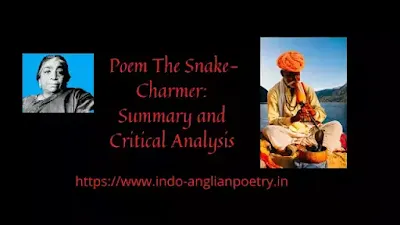Summary of the Poem:
Stanza 1:
The snake charmer wants to catch the snake, so he is extremely eager to know the place where he is hidden. He forbids the snake to flee away from him because his flute has a great charm to call him and he (snake) cannot escape from the call of his flute. He asks the snake which cluster of the perfumed flowers he (snake) has chosen to hide himself and he is lying there beneath the bright moonlight and is also enjoying this gentle and pleasant light. In such dense clusters of scented flowers, the squirrels sleep soundly. The squirrels take complete relax midst the clusters of Keoras flowers. They remain under protection in this cluster. The snake charmer tries to tempt the snake by putting him under the greed of delicious meal such as milk and honey of wild bees. He calls him by showing great love for him.
 |
| Poem The Snake-Charmer: Summary and Critical Analysis |
Stanza 2:
The snake-charmer wants to catch the snake, so he puts him under many temptations. He assures him (the snake) that he will not let him feel any trouble. He will bear him in a very soft manner. He (the snake) will feel much pleasure as he gets beneath the clusters of the scented flowers in the moonlight. He promises him to keep him in basket made of soft and thin grass. The colour of this grass is green and white. He also promises that he will not make his exhibition before the common spectators, but he will carry him in a grand palace where the beautiful maidens wearing the golden dress sit under the shady trees. He (the snake) will be happy among these beautiful maiden. These gay maidens weave numerous patterns of delight with their rapturous smile. The snake-charmer asks him again where he loiters and where his holes are in which he enters and comes out with hissing sound. The snake-charmer shows his excessive eagerness in knowing his hidden place. He asks if he hides in poisonous shrub with beautiful red flowers where the red flowers scatter their majestic colour. Addressing the snake as delicate bride, the snake charmer requests him to accept his proposal of love under the influence of the sweet tunes of his flute. He addresses the snake in the following way such as; he has a silvery breast like the ray of moon. He (the snake) produces, by his beautiful sight, a desire in the onlookers to possess him, as he does in the case of snake- charmer.
Critical Analysis of the Poem:
Introduction:
The poem entitled The Snake-Charmer introduces to the English knowing world, particularly the western world a common sight in India. The snake charmer can be commonly seen even today, whether in the countryside or the town. He moves about, clad in dirty ochre, with a pair of baskets hanging by a swinging bamboo on his shoulders—the baskets he carries contain snakes. It is a song which he sings to woo a snake into his basket. Sarojini Naidu does not consider snakes to be objects of dread or horror. On the contrary, they stand for love and adoration, as they are adorned in the Indian myths and legends. It is a common knowledge that the Indian snake charmer loves his pet immensely. The following lines confirm this fact:
"Come, thou subtle bride of my mellifluous wooing,
Come, thou silver-breasted moonbeam of desire!"
Romantic Atmosphere in the Poem:
The poetess vividly recreates the romantic atmosphere of sweet and delicate perfumes which are very dear to snake. In this poem the snake has been romanticised as:
"Come, thou subtle bride of my mellifluous wooing.
Come, thou silver-breasted moonbeam of desire!"
The snake-charmer woos the snake with the magic of his flute and lovingly requests him to come out of the "moonlight-tangled meshes of perfume". He will feed the snake on mild and wild red honey and bear him in a basket of green and white rushes. He will carry him :
"To a palace-bower where golden-vested maidens
Thread with mellow laughter the petals of delight."
The Poetess' Love for the Snake:
The moment the poetess addresses the snake as "thou subtle bride", all the hideous and the horrible, normally associated with a serpent, are dispensed with. The poet's love for the creature is evident in the following description:
"I'll bear thee in a basket of rushes, green and white,
"To a palace-bower where golden-vested maidens
Thread with mellow laughter the petals of delight."
Style and Language:
The poetess here creates a fairly world of fragrance, colour and romance couched in felicitous phraseology and melodious rhythm. Note the images evoked by the expressions and phrases: "thread with mellow laughter the petals of delight"; "golden-vested maidens"; "subtle bride of my mellifluous wooing"; "silver- vested moonbeams of desire" etc. The atmosphere of the poem is sweet with the melody of words and the beauty of pictures. Sensuousness and picturesqueness are the cardinal features of this poem:
"Whither dost thou hide from the magic of my flute-call?
In what moonlight-tangled meshes of perfume,
Where the clustering keoras guard the squirrel's slumber,
Where the deep woods glimmer with the jasmine's bloom?"
